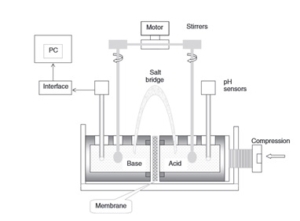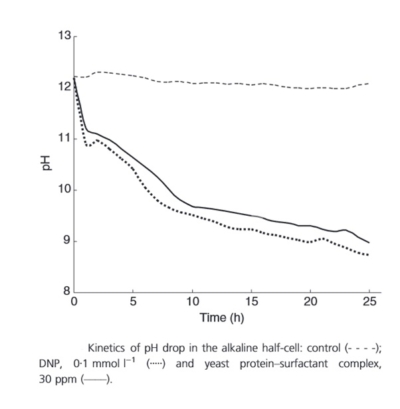The Science behind FGX3

Yeast protein-surfactant complexes uncouple microbial electron transfer and increase transmembrane leak of protons.
Yeasts release amphitropic small molecular chain proteins when subjected to heat shock. Studies have indicated they may play an important role in membrane biochemistry (see Nakamoto and Vigh 2007). Decontamination blends of FGX3 have been used environmentally demonstrating their efficacy in drastically reducing interfacial tension in water⁄hydrocarbon and water⁄oil systems. They were successfully applied for degreasing sewer lines, cleaning of soils contaminated with petroleum oil, reducing biofilm in reverse osmosis membranes.
 Kinetics of pH-gradient driven passive proton leak across a membrane representing closely the mechanics of a bacterial membrane were measured in the presence of some standard uncouplers of oxidative phosphorylation; as well as in the presence of the yeast proteins and their complexes with synthetic surfactants. Standard uncouplers tested were 2,4-dinitrophenol (DNP) and lauric acid. DNP is known to uncouple oxidative phosphorylation by carrying protons across mitochondrial and bacterial membranes, thereby suppressing the formation of ATP, short-circuiting and thus accelerating electron transfer. Cells partially compensate for the decreased yield of ATP by oxidizing more nutrients, consuming more oxygen and producing more carbon dioxide. It was previously shown that uncoupling by DNP results in accelerated waste water decontamination, among other effects (Shah et al. 1975; Low and Chase 1998). Chen et al. (2004) and Ye and Li (2005), following the same line of reasoning, applied another chemical uncoupler, tetrachlorosalicylanilide, to reduce activated sludge production in bench experiments. Lauric acid, as a weak acid with a hydrophobic tail that renders its membrane-soluble, also acts as a protonophore-type uncoupler (Garlid et al. 1996). The experiments with artificial membranes demonstrate that the heat-shock protein complexes indeed accelerate proton transfer across membrane with an effect comparable to the standard uncouplers: DNP and lauric acid.
Kinetics of pH-gradient driven passive proton leak across a membrane representing closely the mechanics of a bacterial membrane were measured in the presence of some standard uncouplers of oxidative phosphorylation; as well as in the presence of the yeast proteins and their complexes with synthetic surfactants. Standard uncouplers tested were 2,4-dinitrophenol (DNP) and lauric acid. DNP is known to uncouple oxidative phosphorylation by carrying protons across mitochondrial and bacterial membranes, thereby suppressing the formation of ATP, short-circuiting and thus accelerating electron transfer. Cells partially compensate for the decreased yield of ATP by oxidizing more nutrients, consuming more oxygen and producing more carbon dioxide. It was previously shown that uncoupling by DNP results in accelerated waste water decontamination, among other effects (Shah et al. 1975; Low and Chase 1998). Chen et al. (2004) and Ye and Li (2005), following the same line of reasoning, applied another chemical uncoupler, tetrachlorosalicylanilide, to reduce activated sludge production in bench experiments. Lauric acid, as a weak acid with a hydrophobic tail that renders its membrane-soluble, also acts as a protonophore-type uncoupler (Garlid et al. 1996). The experiments with artificial membranes demonstrate that the heat-shock protein complexes indeed accelerate proton transfer across membrane with an effect comparable to the standard uncouplers: DNP and lauric acid.
